
NaturBornholm, located in Aakirkeby, is an interpretive centre on the Danish island of Bornholm. It is dedicated to the geology and natural history of the island. It was inaugurated on 16 May 2000.

NaturBornholm, located in Aakirkeby, is an interpretive centre on the Danish island of Bornholm. It is dedicated to the geology and natural history of the island. It was inaugurated on 16 May 2000.
The museum was designed by Henning Larsen. The building employs gabions. This technique, though originating in engineering, was popularized by Herzog and de Meuron in their design of the Domus Winery in Napa Valley. [1]
| | This section is empty.You can help by adding to it.(February 2013) |

Nexø, sometimes spelled Neksø, is a town on the east coast of the Baltic island of Bornholm, Denmark. With a population of 3,607, it is the second largest town, as well as the largest fishing port on the island. Fishing is the mainstay of the town's economy. Nexø is also the site of a distillery and a mustard factory. The town is also a port of call for the passenger ferries linking Bornholm with Kołobrzeg, Darłowo, and Ustka in Poland. Dueodde, the largest beach on Bornholm, is located south of Nexø, in the southeastern corner of the island.

Allinge-Sandvig is a small town on the northern coast of the Baltic island of Bornholm, Denmark. Its population is 1,491. It was part of the former municipality Allinge-Gudhjem. Sandvig is the northernmost part of the town.

The Bornholm Art Museum is situated on the Danish island of Bornholm, above the Sanctuary Rocks (Helligdomsklipperne) about 6 kilometres north-west of Gudhjem, Denmark.
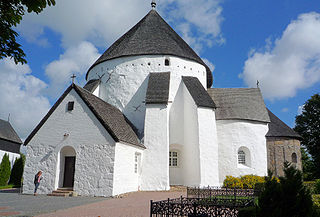
Østerlars Church is a historic building located just north of the village of Østerlars, 5 kilometres (3.1 mi) south of Gudhjem on the island of Bornholm, Denmark. It is the largest and, possibly, the oldest of the island's four round churches.

Østermarie is a village on the Danish island of Bornholm, 8 km (5.0 mi) west of Svaneke. Founded ca. 1880, its old church, now a ruin, dates back to the 12th century. The population as of 1 January 2020 is 490.
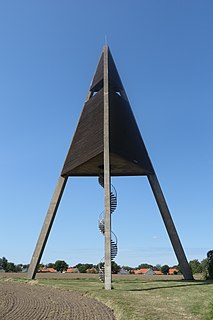
The Svaneke water tower, in the small town of Svaneke on the Danish island of Bornholm, was designed by award-winning architect Jørn Utzon and completed in 1952. It was the first successful project of the architect who would later design the Sydney Opera House.

Sankt Ols Kirke, also known as Olsker Church, is a 12th-century round church located in the village of Olsker, 4 km (2.5 mi) south of Allinge on the Danish island of Bornholm. Built in the Romanesque style and reaching three storeys high, it has from the beginning consisted of a round nave, a choir and an apse.

Østermarie Church, in the village of Østermarie near Svaneke on the Danish island of Bornholm, was originally built in the early 13th century. While it was being demolished in 1890, it was discovered it was of considerable architectural interest and work was stopped. The new church from 1891 is also in the Romanesque style.

Gudhjem Church is the parish church of Gudhjem on the north coast of the Danish island of Bornholm. Completed in 1893, it replaces the now ruined St Anne's Chapel.

Vestermarie Church is located in the little village of Vestermarie some 8 km east of Rønne on the Danish island of Bornholm. The present Neo-Romanesque church replaces a now demolished 14th-century building.

Tejn Church is located at Tejn on the north-east coast of the Danish island of Bornholm. The most recent of the island's churches, it was built in 1940 to a Functionalist design by Emanuel Grauslund (1901-1951). It is a simple, whitewashed building on a granite base with rectangular, small-paned windows and a red-tiled roof.

Almindingen is one of the largest forests in Denmark. It is located in the centre of the island of Bornholm. The forest covers 3,800 hectares, making it Denmark's third largest. Though it was at one time common grazing land for cattle, it was fenced in for forestry in 1809 by Hans Rømer, the forest supervisor. As a result, by the beginning of the 20th century, Bornholm had become Denmark's most forested region.
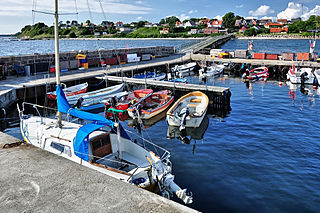
Arnager is a small fishing village in Rønne parish, Bornholm island, Denmark. It is approximately 3 kilometres (1.9 mi) southwest of Nylars, about 8 kilometres (5.0 mi) southeast of Rønne, and approximately 3 kilometres (1.9 mi) southeast of Bornholm Airport. Its population in 2010 was 151 residents. Arnager Bay is east of Arnager.

Østerlars is a village in the northeast of the Danish island of Bornholm, 6 kilometres (3.7 mi) south of Gudhjem and 5 kilometres (3.1 mi) northwest of Østermarie. It is best known for its round church, the largest on the island. 1. January 2020 it had a population of 237.
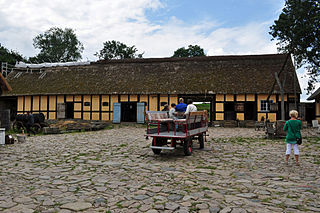
Melstedgård, also known as Bornholms Landbrugsmuseum, is an old farm 13 kilometres (8.1 mi) west of Svaneke on the Danish island of Bornholm. Built in 1801, the half-timbered farmhouse now serves as the centre of a farming museum. One of its main attractions is the windmill, Tejn Mølle, which opened in 2009. Melstedgård is operated s a part of the Bornholm Museum.
Bornholms Middelaldercenter is a family attraction near Østerlars in northeastern Bornholm, Denmark.

Sorthat-Muleby is a village in the southwest of the Danish island of Bornholm, 6 kilometres (3.7 mi) north of Rønne and 4 kilometres (2.5 mi) south of Hasle. Muleby to the north and Sorthat to the south now form a single urban area. As of 2020, it has a population of 512.

Vestermarie is a village midway between Rønne and Aakirkeby on the Danish island of Bornholm. As of 2020, it has a population of 250.
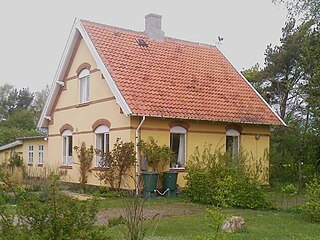
Balka, also Balke, is a village and seaside resort midway between Nexø and Snogebæk on the southwest coast of the Danish island of Bornholm. As of 2020, it has a population of 211. It is best known for its wide beach with fine white sand.

Louisenlund, some 3.5 kilometres (2.2 mi) east of Østermarie on the Danish island of Bornholm, is a site with one of Denmark's largest collection of megaliths. Some 50 stones standing upright among the trees, many of them over 2.5 metres high. Gryet, a similar site in a wood near Bodilsker west of Nexø once had over 60 megaliths but many have now been removed.
| Wikimedia Commons has media related to NaturBornholm . |
| | This article related to a museum in Denmark is a stub. You can help Wikipedia by expanding it. |